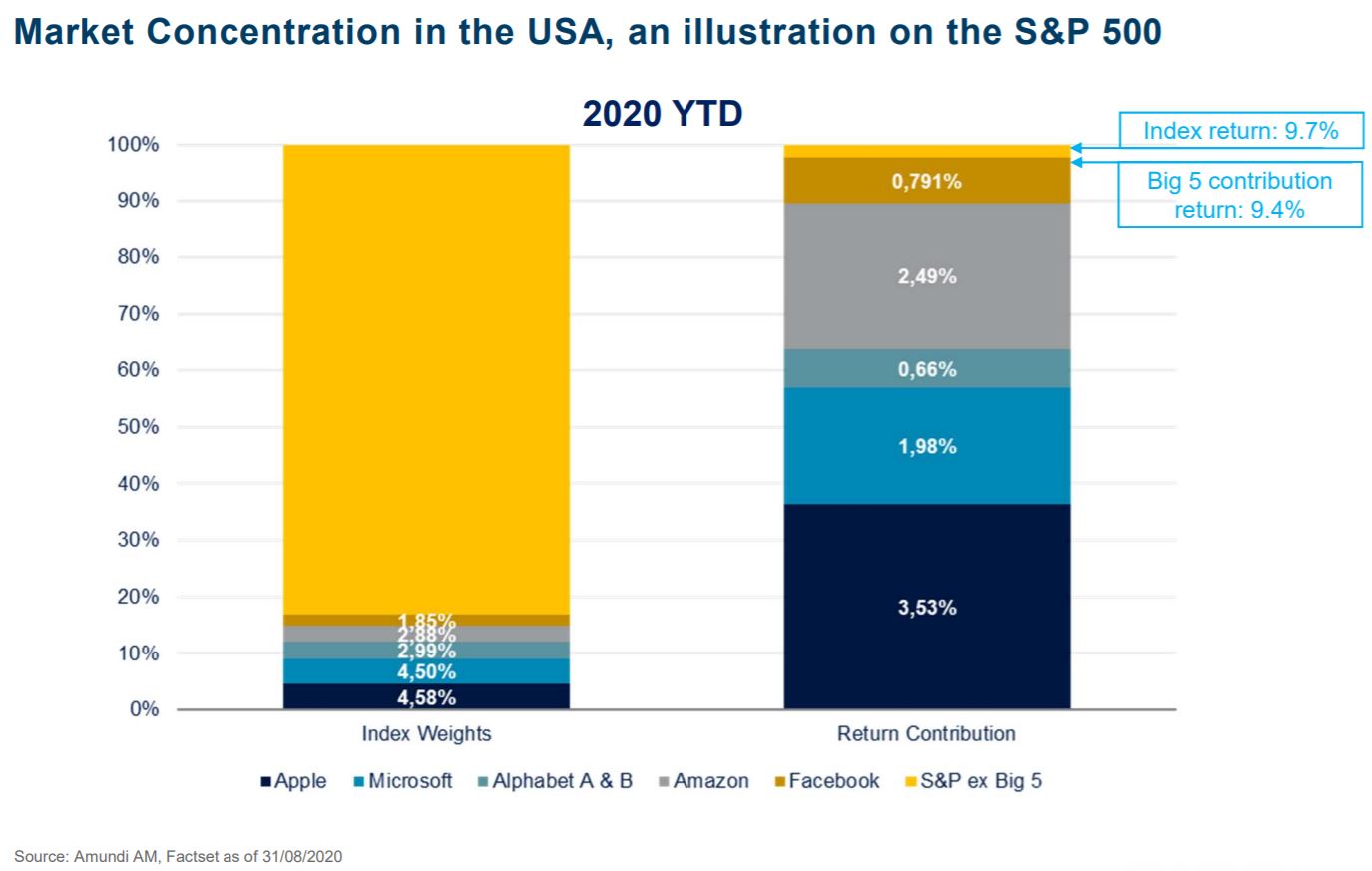ETF Stream’s inaugural Beyond Beta Europe Digital event took place on 23 and 24 September. The event put each factor under the microscope to see which ones have performed well, which ones have underperformed and what surprises have been seen in 2020.
A topic that was frequently discussed was the five leading US tech stocks, contributing to the majority of returns in the S&P 500 which resulted in many factors to appear to perform badly. Highlighting this, Bruno Taillardat, global head of smart beta and factor investing at Amundi, noted how Apple, Microsoft, Google, Amazon and Facebook have contributed 9.4% out of 9.7% of the S&P 500’s returns this year, as at 31 August.

Additionally, the growing interest in environmental, social and governance (ESG) resulted in a discussion on whether the strategy can be included as a factor or whether the conflicting data methodologies is holding it back.
Value’s underperformance over the past decade has been well documented but with markets rebounding, could value finally redeem itself for investors?
The first day of the two-day event began with an opening keynote by Taillardat who commented on the performances of each factor and the drivers behind them.
The Road to Beyond Beta Europe Digital: When will value make a comeback?
Taillardat highlighted value’s underperformance since the beginning of the year following the turbulent period seen in March. Additionally, the size factor was also significantly impacted during this period but would go on to recover in the following weeks.
Low volatility performed well during the crisis, but it began to turn negative as volatility in the market began to fall. Momentum was also a strong performer, according to Taillardat, and has been the best performing factor year-to-date.
He continued by addressing the impact concentration risk has had on portfolio construction in recent years. As an example, the five largest stocks in the S&P 500 – Apple, Microsoft, Google, Amazon and Facebook – represent over 16% of the index composition but account for nearly 95% of the index’s return.
If one were to exclude these stocks from the index, it would underperform by roughly 10% in 2020 alone which suggests these companies offer some protection against the downward trend seen earlier this year.
The next discussion was an interview with Andrew Lapthorne, global head of quantitative research at Société Générale, which continued the debate about the impact the largest US stocks are having on factors.
Lapthorne highlighted how the FAANGs have also been driving the market which has caused value to underperform even more. In fact, the MSCI World ex USA index has underperformed the MSCI World by 5% per annum.
Therefore, if you were to compare a value index with the MSCI World ex USA index, it would not look as disappointing. He continued by describing value as a “call option on good news”; an investor buys it in the hope that the good news will appear, however, he added that buying value after seeing the good news is a pointless exercise.
At the end of the first session, Riccardo Rebonato, Professor of Finance at EDHEC Risk-Institute, discussed factor investing in the time of quantitative easing.
Combining low volatility and momentum
Rebonato explained how the involvement of the Federal Reserve with keeping stability within the economy has changed since the Global Financial Crisis (GFC). He also highlighted the Fed’s chairman Jerome Powell's statement recently that this is “the end of pre-emptive monetary strikes”. This, he said, means the Fed will only raise rates if there are pressures coming from the economy.
WisdomTree Asset Management’s Pierrre Debru, Gilles Prince of Edmond de Rothschild and Tavistock Wealth’s John Leiper discussed how investors incorporate factor ETFs into their portfolios during heightened volatility.
Gilles said he came into 2020 anticipating a cyclical slowdown and therefore overweighted quality. He continued by pointing out that investors have witnessed the longest extension of the economic cycle but the shortest contraction. An expectation of a recession in 2020 resulted in low volatility and quality to perform well.
Shifting focus onto value, defining the factor by price-to-book using tangible assets on the balance sheets in now transitioning to the use of intangible assets, according to Leiper.
By using this new definition, Leiper said research has found value’s underperformance relative to growth did not start from the GFC in 2008 but rather a few years later in 2014.
Debru concluded by saying factors are well-diversified so combining them together in a portfolio can add deliver a superior risk-return profile. The only issues investors will face is what factors to select and the weighting of each one.
Day one rounded off with an interview with Jason Hsu, founder, chairman and CIO of Rayliant Global Advisors which touched on how factors work within emerging markets. The retail audience participation in the Asian emerging markets is far more prominent and therefore, there is a greater risk premium, according to Hsu.
Furthermore, momentum is extremely popular among these markets as a result of gambling being so common among retail investors. With these investors seeking high beta stocks, the institutional investors then seek the low volatility and value trades which will most likely trade at discounts.
Day two began with a presentation from Bank of America’s Dr Kyriakos Chousakos on harvesting macroeconomic risk premia. Chousakos began by revealing the challenge of selecting measures of economic activity that are relevant for asset prices.
The metrics used include information that is collected from private and public sources, can be distributed from weekly to bi-annually and will have some form of data come in every day.
He went on to explain Bank of America’s approach to taking this information to get a better understanding of the macro economy by using medium-term changes.
This presentation was followed by an interview with the founder of Research Affiliates, Rob Arnott, who reiterated value’s underperformance was caused by the leading stocks which accelerated during the coronavirus turmoil.
However, he explained that we are in a “growth-dominated, momentum-chasing bubble”, and the top companies will falter when this bubble bursts.
Arnott also argued that the falling death rates from coronavirus in western Europe will see central banks pull back their stimulus. This would result in markets needing to search for fair value.
Despite the Fed stating it would provide support until 2023, he stressed that he does not think this could continue at a multi-trillion pace if we approach herd community.
Next up was Koris International’s Anaelle Ubaldino who demonstrated how to correctly implement low volatility.
Koris International uses a model that gauges the probability low volatility will outperform depending on three categorised variables: macro, market and factor. Ubaldino explained how the binary signal accurately predicts whether markets are going to perform positively or negatively as a result of a change in volatility.
She concluded by highlighting how low volatility stocks have a premium over the long term as well as having defensive behaviour during market stress.
The penultimate session was a discussion on ESG with Victor Gomez, founder and CEO of Bita, Niina Arkko, responsible investment analyst at Ilmarinen and FactorReasearch’s Nicolas Rabener.
Gomez began by stating how regulation and clients have encouraged index providers to transition their ESG indices, most notably climate indices, to Paris-aligned benchmarks (PAB) or climate transitioned benchmarks (CTB). The strategies for these products now have to include a number of metrics to record the greenhouse gas emissions for each company to ensure they comply with the benchmarks.
The Road to Beyond Beta Europe Digital: ESG ETF innovation
Regardless of if you look at either of the three pillars of ESG, there are alarm bells when looking at sustainable investing through the lens of performance, according to Rabener. The active fund management side has failed to achieve outperformance, but the research side has shown it is possible. This, however, is mainly being driven by the environmental key.
From an investor perspective, Arkko said how Ilmarinen takes a holistic approach when it comes to ESG and therefore seeks products that take a deep approach across all three pillars. Additionally, the firm actively engages with both companies and index providers to develop incentives for these companies to set targets and improve their ESG credibility.
Continuing the discussion on ESG into the final discussion was Elroy Dimson from the University of Cambridge who said the strategy should not create outperformance. Investors would only benefit by being a part of the journey as companies transition to a responsibly managed company from a poorly managed one.
He did not agree with being able to achieve excess returns by investing in stocks that have gone through a screening process and have achieved a high ESG score.
In response to how one should calculate the equity risk premium at the moment, Dimson concluded by saying it is extremely difficult to calculate it better than by looking at a long-term average. The long-term average is roughly 3.5% while the risk-free rate is probably less than zero in real terms or closer to zero in nominal terms.





